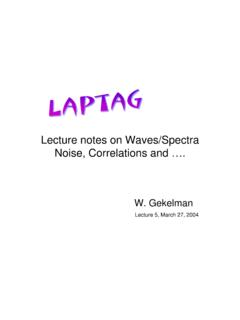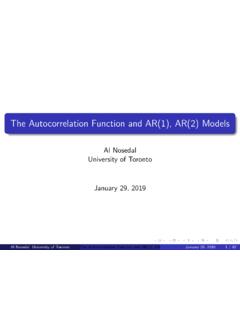Search results with tag "The autocorrelation"
Chapter 11 Autocorrelation - IIT Kanpur
home.iitk.ac.inThe autocorrelation is present in cross-section data as well as time-series data. In the cross-section data, the neighbouring units tend to be similar with respect to the characteristic under study. In time-series data, time is the factor that produces autocorrelation. Whenever some ordering of sampling units is present, the autocorrelation may ...
Power Signals: Power Spectral Density and Autocorrelation …
tele1.dee.fct.unl.ptThe autocorrelation has a maximum (possibly a local one) at τ = 0. 3 P7.x 0f This can be seen considering (3) P8. ()* RRxx−=τ τ This comes from (2) and means that the real part of the autocorrelation is symmetric and the argument part of the autocorrelation is anti-
Chapter 9 Autocorrelation - IIT Kanpur
home.iitk.ac.inThe autocorrelation function begins at some point determined by both the AR and MA components but thereafter, declines geometrically at a rate determined by the AR component. In general, the autocorrelation function - is nonzero but is geometrically damped for AR process.
Autocorrelation Function - University of Delaware
www.physics.udel.eduThe autocorrelation function tells us the time interval over which a correlation in the noise exists. If the noise is made entirely of waves, and the waves move through the plasma (or other medium) without decaying as they travel, the autocorrelation will be large for all time. 1 1 1 ( …
The Autocorrelation Function and AR(1), AR(2) Models
mcs.utm.utoronto.caautocorrelation is a common occurrence in business and economic time series. The null hypothesis for this test is that there is no autocorrelation. A one-tailed test is used: H 0: ˆ= 0 vs H a: ˆ>0 In the Durbin-Watson test, D is the observed value of the Durbin-Watson
The autocorrelation function and the rate of change
www.ece.tufts.eduThe autocorrelation function and the rate of change † Consider a WSS random process X(t) with the autocorrelation function RX(¿). † If RX(¿) drops quickly with ¿, then process X(t) changes quickly with time: its time samples become uncorrelated over a short period of time. { Conversely, when RX(¿) drops slowly with ¿, samples are highly





